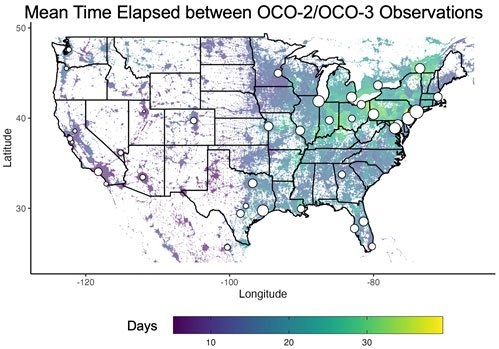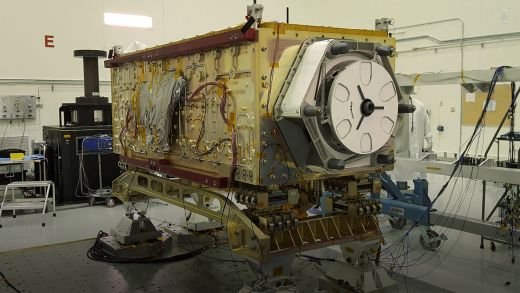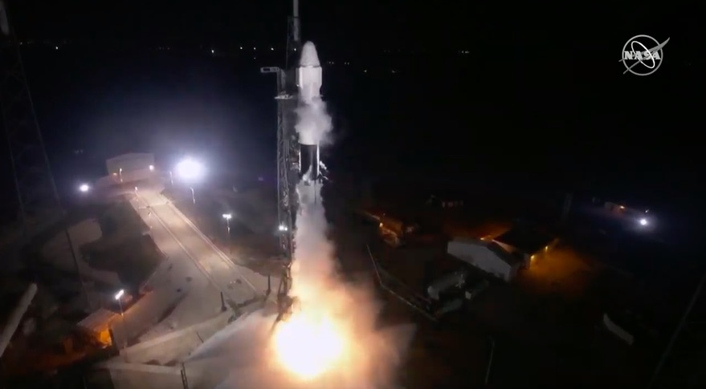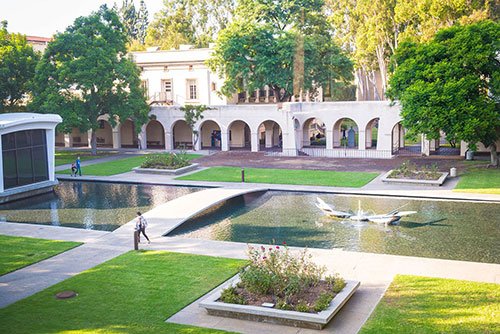
Figure shows the predicted amount of time that elapses between observations with the OCO-2 and OCO-3 instruments. The white points indicate the cities routinely targeted by OCO-3 SAM mode while their size represents the number of unconstrained emissions released between observations.
In recent years, spaceborne CO2 observations from the OCO-2 and OCO-3 missions have been successfully ingested into local, regional, and national carbon accounting methodologies. However, all spaceborne observations are influenced by physical and environmental factors such as clouds and aerosols that affect their coverage. A new study by Roten et al. ( Coverage-Limiting Factors Affecting the Monitoring of Urban Emissions With the Orbiting Carbon Observatory Missions ) investigated these factors and determined that the time needed to constrain emissions varies among cities within the United States.
The OCO-3 project is now producing new daily bias-corrected Level 2 forward stream XCO2 and SIF data products. These data products were developed for users who would like to use OCO-3 data within a week of the observations being taken. Daily bias corrected forward stream products are also available for OCO-2. Note that the Lite XCO2 and Lite SIF products, produced from the retrospective stream on a monthly cadence, remain as our reference records. The bias corrected forward stream XCO2 and SIF products are now available at the GES DISC.
Learn more about daily OCO-3 bias corrected forward stream products:
A recent article published in Journal of Remote Sensing investigates the vegetation response of drought in the Yangtze River Basin using high-resolution hourly SIF data that is generated by combining SIF retrievals from OCO-2 and OCO-3. This high-resolution SIF data may reveal the critical adaptive responses of vegetation across different biomes, providing key insights into ecosystem resilience amid climatic variability.
Read the article: Response of Vegetation Photosynthesis to the 2022 Drought in Yangtze River Basin by Diurnal Orbiting Carbon Observatory-2/3 Satellite Observations
The JPL Vicarious Calibration team are out on the playa at Railroad Valley, Nevada, this week. The team are making a range of measurements on the ground to inform ongoing analyses of the quality and stability of the calibration of the OCO-2 and OCO-3 missions.

A recent article published in IEEE Transactions on Geoscience and Remote Sensing captures the improvements to the calibration of the OCO-3 instrument, including a novel approach to use non-traditional datasets (such as clear ocean scenes) to correct changes in the spectral shape of the instrument response.
Read the article: New Inflight Calibration of OCO-3’s A-Band for Version 11 Products >
How well can current sensors detect emissions from small point sources? A new study looks at the detection limit of OCO-2 Targets and OCO-3 SAMs for quantifying emissions from coal power plants, a Carbon Capture Utilization and Storage (CCUS) facility and oil sands extraction and processing facilities.
Read the article: Quantifying CO2 Emissions From Smaller Anthropogenic Point Sources Using OCO-2 Target and OCO-3 Snapshot Area Mapping Mode Observations >
A recent article published in Geophysical Research Letters highlights environmental factors and conditions that impact the diurnal patterns of ecosystem gross primary production (GPP).
Read the article: Atmospheric Dryness Dominates Afternoon Depression of Global Terrestrial Photosynthesis >
Some people ride bikes, buses, or trains to work. That can mean fewer cars on the road, and that can lead to less carbon dioxide emissions, the main gas driving climate change and the warming of our planet. The big question is, how much do emissions actually fall when we make these efforts? It's tough to calculate. We need detailed road and fuel data that most cities don't have. So NASA is working on another way to do it -- from space, with the help of OCO-2 and OCO-3.
A new paper, Comparing Point Source CO2 Emission Rate Estimates From Near-Simultaneous OCO-3 and EMIT Observations, published in Geophysical Research Letters by members of the OCO-3 Science Team, compares CO2 emission rate estimates from two distinct space-based sensors – OCO-3 and EMIT, both perched on the ISS. This study is the first of its kind to use near-simultaneous CO2 measurements from these two sensors to estimate power plant emissions.
OCO-3 has successfully exited IOC#2 and returned to nominal science operations. Science data collected during IOC#2 have now been delivered to GES-DISC.
OCO-3 was successfully reinstalled back to its original location on the International Space Station on July 4, 2024. OCO-3 had been in storage on the ISS since November 2023 to let another payload complete its nominal mission. Following reinstallation, OCO-3 Mission Operation Systems (MOS) began the In-orbit Checkout (IOC#2) procedures and successfully completed preliminary tests. OCO-3 returned to earth-pointing on July 14, 2024, and science data collection began from July 16, 2024. Our OCO-3 MOS Team continues with IOC#2 activities as we assess geolocation, calibration and other instrument parameters over the next 6-8 weeks. We will have a final decontamination cycle in mid-to-late September when we formally exit IOC#2, and resume nominal science operations and data delivery to the GES-DISC.
NASA’s Applied Remote Sensing Training Program (ARSET) has opened a new open, online webinar series: Applications of Carbon Dioxide Measurements for Climate-Related Studies. This intermediate, three-part webinar series will build on the previous CO2 training from 2022, providing a more in-depth review of OCO-2 and OCO-3 measurements along with demonstrations of case-studies.
Registration is now open! If you would like to join us or pass along to colleagues who will find it useful, please do so.
Five years ago, at 2.48 am ET on May 4th, SpaceX launched the CRS-17 cargo mission that carried the OCO-3 instrument up to the International Space Station. Happy Launch Anniversary, OCO-3!
Observing CO2 from space: A Decade of progress from NASA’s Orbiting Carbon Observatories (OCO-2 and OCO-3)
Submission deadline: Wednesday, 31 December 2025
Advancing quantification of sources and sinks and understanding of carbon cycle science demand collaborative efforts spanning a range of communities. In celebration of the impending 10-year milestone of OCO-2 and the 5-year anniversary of OCO-3 in 2024, we extend an invitation to scholars across these communities to submit articles on the following topics:
This Special Issue aims to not only revisit past advancements and the wisdoms but also to serve as a platform for the dissemination of the latest breakthroughs. Every type of paper is welcome, but each of them must be linked to OCO-2/3.
Submission Guidelines/Instructions
To submit your manuscript, use the standard submission portal of AGU Advances, Earth's Future, Earth and Space Science, Geophysical Research Letters, Global Biogeochemical Cycles, JAMES, JGR-Atmospheres, JGR-Biogeosciences, JGR-Oceans, Reviews of Geophysics, and select the collection’s title from the drop down menu in the Special Section field of the submission form.
NASA has announced selections from the latest round of OCO-2/3 Science Team ROSES proposals.
Congratulations to our new and returning Science Team members!
For more details, on the selections please see: A.31 Science Team for the OCO missions.
We power our daily lives mainly by burning fossil fuels, and this adds greenhouse gases to the air, warming the planet. That's where trees, the ocean, and soil and grasslands come in. They reduce the amount of carbon dioxide in the air. When something takes carbon away from the air, it's called a sink. But NASA's satellites have found these sinks might be changing. Could it be that our sinks stop removing carbon from the air, and add more instead?
October 20, 2023
The team enjoyed a productive hybrid OCO-2/3 Science Team Meeting, in the beautiful setting of the NCAR Mesa Lab in Boulder, CO, 16th-20th October.
Many thanks to all participants, both in-person and virtual and to our gracious NCAR hosts!
July 6, 2023
This week, a number of our team are participating in the 19th International Workshop on Greenhouse Gas Measurements from Space (IWGGMS) in Paris, France. The goal of the workshop is to present and discuss the state of the art in space-based remote sensing of greenhouse gases from space, notably carbon dioxide and methane, and related products.
June 15, 2023
A number of our team are participating in the annual meeting of the NDACC-IRWG / TCCON / COCCON this week in Spa, Belgium: NDACC-IRWG / TCCON / COCCON Annual Meeting
NDACC-IRWG: Network for the Detection of Atmospheric Composition Change - Infrared Working Group
June 1, 2023
Amazonian rainforests play an important role in the climate system by exchanging large amounts of energy, water, and carbon dioxide (CO2) with the atmosphere and acting as a major carbon stock. A new study by Zhang and co-authors uses measurements of SIF from OCO-3 and evapotranspiration from ECOSTRESS to investigate the large-scale diurnal patterns of photosynthesis and ET in the Amazon forest and their responses to atmospheric warming and drying. The results of this study shed new light on the complex interplay of climate with carbon and water fluxes in Amazonian forests and provide a path towards improved robustness of future climate projections. For full details of the study, see here: Large diurnal compensatory effects mitigate the response of Amazonian forests to atmospheric warming and drying

A SpaceX Falcon 9 carrying a Dragon cargo spacecraft lifts off May 4, 2019 from Cape Canaveral, Florida. Credit: NASA TV
May 18, 2023
This month marks the 4th anniversary of OCO-3 on the International Space Station! The instrument was launched on 4th May 2019 and powered on six days later, on May 10th.
May 5, 2023
Zhang and co-authors have used OCO-3 SIF measurements to quantify changes in the photosynthetic uptake of carbon dioxide from plants throughout the course of the day. The global diurnal patterns reveled in this study provide new insight into the responses of photosynthesis to environmental drivers, providing a potential path towards improvements in projections of changes in the carbon cycle with changing climate.
The full article can be found here: Global modeling diurnal gross primary production from OCO-3 solar-induced chlorophyll fluorescence
April 28, 2023
OCO-2 and OCO-3 will have a booth at the Explore JPL event this weekend: https://explore.jpl.nasa.gov/
As part of that event, we will be presenting a talk on Carbon from Space on the hyperwall.
Image/Video Credit: NASA/JPL
April 20, 2023
Hakkarainen and co-authors have used OCO-3 Snapshot Area Map observations together with S5P/TROPOMI tropospheric NO2 columns to characterize a group of major anthropogenic point sources in the South African Highveld region. This study highlights the importance of having multiple transects per plume (from OCO-3 SAMs, or future wide-swath instruments) to quantify complex emission sources.
The full study can be found here: Building a bridge: characterizing major anthropogenic point sources in the South African Highveld region using OCO-3 carbon dioxide snapshot area maps and Sentinel-5P/TROPOMI nitrogen dioxide columns
March 24, 2023
Yang and co-authors have combined OCO-3 XCO2 measurements from the Snapshot Area Mapping mode with NO2 measurements from the European TROPOMI satellite instrument to enhance understanding of urban CO2 emissions. For full details of the study, please see here: Using Space-Based CO2 and NO2 Observations to Estimate Urban CO2 Emissions
Column average carbon dioxide over Mexico City on 5th December, 2022, as observed by the OCO-3 satellite instrument
Large Image >
Nitrogen dioxide (NO2) in the troposphere over Mexico City on 5th December, 2022, as observed by the TROPOMI satellite instrument
Large Image >
See here for the full set of OCO-3 Snapshot Area Map observations >

Image of the Caltech Campus
March 24, 2023
OCO-2 and OCO-3 will be holding a Science Team Meeting in Pasadena 28th - 30th March. We look forward to productive interactions and discussions with the team!
Please reach out to our Project Science Management for further info (vivienne.h.payne@jpl.nasa.gov , abhishek.chatterjee@jpl.nasa.gov , junjie.liu@jpl.nasa.gov)
February 14, 2023
For Valentine's Day, here is a look at CO2 levels over the "City of Love" itself, Paris.
Watch the video: CO2 and the City: Valentine's Day Edition
February 10, 2023
Zhang and co-authors have used measurements of solar induced fluorescence from OCO-3 to estimate the diurnal variation in the uptake of CO2 by plants and have validated these estimates against ground-based flux tower measurements. The resulting hourly dataset can be used to inform and improve biospheric models and their projections of changes in the carbon cycle under climate change.
For more details, please see: Global modeling diurnal gross primary production from OCO-3 solar-induced chlorophyll fluorescence
February 2, 2023
A case study involving Europe’s largest coal-fired power plant shows how spaceborne observations from OCO-2 and OCO-3 can be used to track carbon dioxide emissions - and reductions - at the source.
For more details, please see: NASA Space Missions Pinpoint Sources of CO2 Emissions on Earth
September 20, 2021
The Orbiting Carbon Observatory-3 project would like to announce the release of new L2 data products at the GES-DISC, called v10. This v10 release uses software that is consistent with the OCO-2 data processing. Significant improvements over vEarly include geolocation (v10 has errors of less than 300m for nearly all the data) and a more consistent radiometric calibration across the mission.
The forward stream of data processing has been in v10 since the start of July 2021. These data rely on extrapolated calibration data and are processed for a limited volume of data (6% of the cloud free scenes).
A reprocessing campaign is underway, which focuses on the retrospective data. This uses calibration that relies on interpolation and all cloud-free data is processed, so it is a larger dataset. This campaign is ongoing, so some data has been delivered and additional data will be added in the months ahead, with a plan to complete the reprocessing of the mission record by the end of 2021. These products include XCO2 (dry-air mole fraction of carbon dioxide) and solar-induced fluorescence (SIF) estimates in lite files. These files contain data for one day, including bias correction and filtering for XCO2. The other products, including L2Std and L2Dia are also available.
Links for files:
Links for documentation (note that additional updates will be added in the near term)
Link for Snapshot Area Map and Target data (not all updated, but please save the link):
September 15, 2021
Paul Palmer, a Distinguished Visiting Scientist at JPL who collaborates with the OCO-3 Science Team, and Dr. Doug Finch, have created the first global map of anthropogenic sources of combustion.
They achieved this by training a machine learning model to identify plumes of nitrogen dioxide (NO2), a proxy for incomplete combustion, by feeding it thousands of satellite images from the TROPOMI instrument on board the Sentinel 5P satellite (half containing a plume, half with no plume). The resulting model was successful in identifying plumes above 90% accuracy. Then they fed the model two years of global satellite observations from TROPOMI and found they were able to detect and tag combustion sources, and create a database of emission coordinates and times.
Generally, the located plumes on the maps show concentrations over areas that include cities, ports, industrial areas, and power stations, although night time flaring observations may not be possible with the afternoon satellite overpass of TROPOMI. Plumes from wildfires were identified and removed using thermal anomaly data collected by the VIIRS satellite on board the NOAA-20 weather satellite.
This map provides the potential to identify and monitor new sources.
The OCO-3 instrument on board the ISS uses their CO2 data with the NO2 plume data for analysis. This map could serve to guide the OCO-3 instrument to these sources when collecting Snapshot Area Maps (SAMS).
More results will be coming along. For more information and to view the map, please see here: Satellites reveal anthropogenic combustion hotspots across the globe
June 7, 2021
In a novel map, space-based observations from OCO-3 reveal the increased CO2 concentrations within the Los Angeles area, shaped by fossil fuel emissions and local winds. Please see: Urban-focused satellite CO2 observations from the Orbiting Carbon Observatory-3: A first look at the Los Angeles megacity and NASA Map Gives Most Accurate Space-Based View of LA’s Carbon Dioxide for more information.
May 4, 2021
In celebration of the Crew-2 launch broadcast and Earth Day, Annmarie Eldering (Deputy Project Scientist for OCO-2, Project Scientist for OCO-3), gave a brief interview on Friday, April 23, 2021. This Teams interview was hosted by The International Space Station Program Research Office. Please see video here:
April 28, 2021
NASA has announced results and selections from the latest round of OCO-2/3 Science Team ROSES proposals. We want to welcome new and returning Science Team members (listed below). For more details, please see: NASA Science Mission Directorate Research Opportunities in Space and Earth Sciences–2020 NNH20ZDA001N-OCOST A.51 Science Team for the OCO Missions.
International team members: